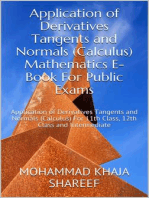Discrete Functions Lessons
Uploaded by
jackietsangggDiscrete Functions Lessons
Uploaded by
jackietsangggNotes:
Number Sequence:
o A sequence is a discrete function with a set of numbers arranged in a specific
order; Example: 2, 5, 8, 11,
o Each element of the sequence is known as a term.
o First term: t
1
= 2; Second term: t
2
= 5; Third term: t
3
= 8
o The n
th
term (also called the general term) is t
n
o Sequences can go on forever as in 5, 9, 13, 17, or stop as in 5, 9, 13, 17.
o In both cases t
1
= 5, t
2
= 9, t
3
= 13, t
4
= 17
o All sequences have their own formula which can give you the value of any term in
the sequence.
o Since each term is identified by its position in the list, the domain is the set of
natural numbers, N = {1, 2, 3, }
o The range is the set of all terms of the sequence.
o Example: 4, 12, 20, 28,
Domain: {1, 2, 3, 4, }, Range: {4, 12, 20, 28, }
Arithmetic Sequence:
o An arithmetic sequence is a recursive sequence in which new terms are created by
adding the same value, called the common difference, each time.
o The variable assigned to the common difference is d.
o d = t
2
t
1
or d = t
3
t
2
or d = t
4
t
3
, etc.
o Example: 2, 6, 10, 14,
o d = t
2
t
1
= 6 2 = 4 or,
o d = t
3
t
2
= 10 6 = 4 or,
o d = t
4
t
3
= 14 10 = 4
.
.
.
o The first term of the sequence is assigned the variable a.
o Therefore:
o t
1
= a
o t
2
= a + d
o t
3
= a + 2d
o t
4
= a + 3d
o t
n
= a + (n 1)d
o An arithmetic sequence can be defined
o By the general term t
n
= a + (n 1)d
o Recursively by t
1
=a, t
n
= t
n-1
+ d, where n > 1 or
o By a discrete linear function f(n) = dn + b, where b = t
0
= a d
o In all cases, n e N, a is the first term, and d is the common difference.
Unit 7: Sequences and Series
7.1 Arithmetic Sequences
Examples:
1. State whether or not each of the following sequences is arithmetic. If a sequence is
arithmetic, state the common difference.
a) 64, 32, 16, 8, 4, ... b) 36, 29, 22, 15, 8, 1, ... c) ,...
2
7
,
2
5
,
2
3
,
2
1
,
2
1
2. For each of the following arithmetic sequences, state the general term and the
recursive formula.
a) 15, 23, 31, 39, 47, 55, ... b) 3, -1, -5, -9, -13, -17,
3. For each of the following formulas, state the first five terms of the sequence.
a)t
n
= 18n 7 b) t
1
= 5, t
n
= t
n-1
- 3
4. Find the 42nd term in the arithmetic sequence 5.5, 8, 10.5, 13, 15.5, ...
5. For the arithmetic sequence, -18, -2 , 14, 30, ..., 126, determine the total number of
terms.
6. The 19th term in an arithmetic sequence is 51, and the 28th term is 96. Find the
35th term.
7. A large movie theatre has 12 seats in the first row, 14 in the second row and so on.
How many seats would be in the 8
th
row? If the last row has 40 seats, how many rows in
total are there in this theatre?
Notes:
o For the sequence 1, 3, 9, 27, ... there is no common difference. t
2
- t
1
t
3
t
2
,
therefore this sequence is not arithmetic.
o However,
3
4
2
3
1
2
t
t
t
t
t
t
= = , therefore each term is created by multiplying the previous
term by the same value each time.
o This value is called the common ratio and is assigned the variable r. In the above
example the common ratio is 3.
o Common Ratio,
1
=
n
n
t
t
r
o If the common ratio is negative, the sequence has terms that alternate from positive
to negative.
Example: 5, -20, 80, -320, ... has a common ratio of -4.
o A geometric sequence with first term a and common ratio r, can be written as;
t
1
= a
t
2
= a x r = ar
t
3
= ar x r = ar
2
t
4
= ar
3
t
n
= ar
n-1
o A geometric sequence can be defined
By the general term t
n
= ar
n-1
,
Recursively by t
1
= a, t
n
= rt
n-1
, where n > 1, or
By a discrete exponential function f(n) = ar
n-1
o In all cases, n e N, a is the first term, and r is the common ratio.
Examples:
1. State whether or not each of the following sequences is geometric. If a sequence is
geometric, state the common ratio.
a) -3, 12, -48 , 192, -768, ... b) 5000, 1000, 200, 40, 8, ...
Unit 7: Sequences and Series
7.2 Geometric Sequences
2. For each of the following geometric sequences, state the general term and the
recursive formula.
a) 1, 7, 49, 343, 2401, ... b) 2, -6, 18, -54 , 162, ... c) ,...
162
1
,
54
1
,
18
1
,
6
1
,
2
1
3. For each of the following formulas, state the first five terms of the sequence.
a) t
1
=3, t
n
=
1
10
1
|
.
|
\
|
n
b) t
1
=123, t
n =
3
1 n
t
4. Find the 14th term in the geometric sequence -10, 5, ,...
8
5
,
4
5
,
2
5
5. The 5th term in a geometric sequence is 1875, and the 7th term is 46 875. Find the
10th term algebraically.
6. For the geometric sequence, -4374, 1458, -486, ,
3
2
, determine the total number of
terms.
Notes:
- An arithmetic series is created by adding the terms of an arithmetic sequence.
- If 1, 3, 5, 7, ... is the sequence, then 1 + 3 + 5 + 7 + ... is the corresponding series.
- The partial sum, S
n
, of a series is the sum of the finite number of terms from the
series. S
n
= t
1
+ t
2
+ t
3
+ ... + t
n.
- Using the example above; S
1
= 1
S
2
= 1 + 3 = 4
S
3
= 1 + 3 + 5 = 9
S
n
= 1 + 3 + 5 + 7 + ...
- The sum of the first n terms of an arithmetic sequence can be calculated using
two formulas:
( ) | |
2
1 2 d n a n
S
n
+
= or
( )
2
1 n
n
t t n
S
+
=
- In both cases, n e N, a is the first term, and d is the common difference.
- You can use either formula, but you need to know the number of terms in the
series and the first term.
- If you know the last term, use the formula in terms of t
1
and t
n
. If you can
calculate the common difference, use the formula in terms of a and d.
Examples:
1. Determine the sum of the first 30 terms of the arithmetic series, 5 + 5.3 + 5.6 + ...
2. Determine the sum of each arithmetic series.
a) 31 + 35 + 39 + ... + 107 b) 13 + 10 + 7 + ... - 62
Unit 7: Sequences and Series
7.3 Arithmetic Series
3. For three summer months (12 weeks), Job A pays $400 per month with a monthly
increase of $20. Job B pays $100 per week with a weekly increase of $5. Which is
the best deal and by how much?
4. For the arithmetic series 6 + 9 + 12 + 15 + ...
a) Determine the 20
th
term.
b) Determine the sum of the first 20 terms.
Notes:
- A geometric series is created by adding the terms of a geometric sequence.
- For the sequence 3, 6, 12, 24, ..., the related geometric series is
3 + 6 + 12 + 24 + ...
- The sum of the first n terms of a geometric sequence can be calculated using two
formulas;
( )
1
1
=
r
r a
S
n
n
or
1
1 1
=
+
r
t t
S
n
n
, where r 1
- In both cases, n e N, a is the first term, and r is the common ratio.
- You can use either formula, but you need to know the common ratio and the first
term.
- If you know the (n + 1)
th
term, use the formula in terms of t
1
and t
n+1.
- If you can calculate the number of terms, use the formula in terms of a, r, and n.
Examples:
5. Determine the sum of the first 8 terms of the given geometric series.
a) 6 + 24 + 96 + 384 + ... b) 6 24 + 96 384 + ...
6. For the geometric series 4 + 12 + 36 + 108 + ...
a) Determine the 10
th
term.
b) Determine the sum of the first 10 terms.
Unit 7: Sequences and Series
7.4 Geometric Series
7. For the geometric series 3 + 6 + 12 + ... + 3072.
a) Determine the number of terms.
b) Calculate the sum of the series.
8. Given the following information which is the better deal?
Prize 1: You could win $1 today, $2 one year from now, $4 two years from now,
etc. for the next 20 years.
Prize 2: You could win $1, 000, 000 today.
9. A ball is thrown 10m into the air and rebounds to half of its previous height each
time. Find the total distance the ball travels when it hits the ground for the 6
th
time.
Notes:
Pascals Triangle:
- The arrangement of numbers shown is called Pascals Triangle. Each row is generated
by calculating the sum of pairs of consecutive terms in the previous row.
1 Row 0
1 1 Row 1
1 2 1 Row 2
1 3 3 1 Row 3
1 4 6 4 1 Row 4
1 5 10 10 5 1 Row 5
Pascals triangle has many interesting relationships among its numbers. Some of these
relationships are recursive:
- For example, down the sides are constant sequences: 1, 1, 1, .
- The diagonal beside that is the counting numbers, 1, 2, 3,, which form an arithmetic
sequence
- The next diagonal 1,3,6,10, which can be defined by the recursive formula
- n t t t
n n
+ = =
1 1
, 1 where N ne and n > 1.
The numbers in Pascals triangle correspond to the coefficients in the expansion of
binomials raised to whole-numbers exponents.
Recall: (a + b)
0
=
(a + b)
1
=
(a + b)
2
=
(a + b)
3
=
Unit 7: Sequences and Series
7.5 Pascals Triangle and Binomial Expansion
There are patterns in the expansion of a binomial (a +b)
n:
-
Each term in the expansion is the product of a number from Pascals triangle, a
power of a, and a power of b.
- The coefficients in the expansion correspond to the numbers in the nth row in
Pascals triangle.
- In the expansion, the exponents of a start at n and decrease by 1 down to zero,
while the exponents of b start at zero and increase by 1 up to n.
- In each term, the sum of the exponents of a and b is always n.
Examples:
1. Expand and simplify
a) (x + 2)
3
b) (2x - 3)
4
c) (3x
2
2y
3
)
5
You might also like
- A A N D: Arithmetic and Geometric SequencesNo ratings yetA A N D: Arithmetic and Geometric Sequences8 pages
- Discrete Functions MCR3U Unit 8 (May 2015)No ratings yetDiscrete Functions MCR3U Unit 8 (May 2015)18 pages
- Empty Notes Unit 7: Series and SequenceNo ratings yetEmpty Notes Unit 7: Series and Sequence30 pages
- SSIP 2023 LEARNERS' NOTES Term 1 Mathematics (Session 1 - Session 4)No ratings yetSSIP 2023 LEARNERS' NOTES Term 1 Mathematics (Session 1 - Session 4)44 pages
- Arithmetic and Geometric Sequence - Lesson&ActivityNo ratings yetArithmetic and Geometric Sequence - Lesson&Activity7 pages
- Chapter 5 - Sequence and Series (Week 6)No ratings yetChapter 5 - Sequence and Series (Week 6)7 pages
- Find Terms of Sequences Given The General or NTH Term. Convert Between Sigma Notation and Other Notation For A SeriesNo ratings yetFind Terms of Sequences Given The General or NTH Term. Convert Between Sigma Notation and Other Notation For A Series99 pages
- Pre-Calculus 11.2 Homework Name - (Day 2) Sequences & Series Worksheet (2015)No ratings yetPre-Calculus 11.2 Homework Name - (Day 2) Sequences & Series Worksheet (2015)8 pages
- Find A Formula or Conjecture For Each of The Patterns Shown Below, and Give The Next Three Terms of Each PatternNo ratings yetFind A Formula or Conjecture For Each of The Patterns Shown Below, and Give The Next Three Terms of Each Pattern48 pages
- What Is An Arithmetic Sequence?: Arithmetic Sequences and SeriesNo ratings yetWhat Is An Arithmetic Sequence?: Arithmetic Sequences and Series34 pages
- Pre Cal-Q1 M7 SERIES-AND-SEQUENCE EditedNo ratings yetPre Cal-Q1 M7 SERIES-AND-SEQUENCE Edited16 pages
- Grade12 Ch1 Sequence Series Revision Day 29No ratings yetGrade12 Ch1 Sequence Series Revision Day 299 pages
- Chapter 2 Patterns Sequences and SeriesNo ratings yetChapter 2 Patterns Sequences and Series42 pages
- Understanding Math10 (Teacher's Guide) PDFNo ratings yetUnderstanding Math10 (Teacher's Guide) PDF139 pages
- Number Patterns, Sequences and Series Grade 12 Notes - Mathematics Study GuidesNo ratings yetNumber Patterns, Sequences and Series Grade 12 Notes - Mathematics Study Guides20 pages
- Pages From New Concise Project Maths 5 For Leaving Certificate Higher LevelNo ratings yetPages From New Concise Project Maths 5 For Leaving Certificate Higher Level43 pages
- Week 7 Module 7 1st Quarter Pre CalculusNo ratings yetWeek 7 Module 7 1st Quarter Pre Calculus10 pages
- Trigonometric Ratios to Transformations (Trigonometry) Mathematics E-Book For Public ExamsFrom EverandTrigonometric Ratios to Transformations (Trigonometry) Mathematics E-Book For Public Exams5/5 (1)
- Application of Derivatives Tangents and Normals (Calculus) Mathematics E-Book For Public ExamsFrom EverandApplication of Derivatives Tangents and Normals (Calculus) Mathematics E-Book For Public Exams5/5 (1)
- DIE - Arthur T. Benjamin, Jennifer J. Quinn - XNo ratings yetDIE - Arthur T. Benjamin, Jennifer J. Quinn - X12 pages
- Summative Test in Intermediate Algebra 8No ratings yetSummative Test in Intermediate Algebra 82 pages
- Session-22: The Binomial & Multinomial CoefficientsNo ratings yetSession-22: The Binomial & Multinomial Coefficients7 pages
- Philippine Science High School - Bicol Region CampusNo ratings yetPhilippine Science High School - Bicol Region Campus4 pages
- Maths Extension 1 - Binomial Theorem & Binomial ProbabilityNo ratings yetMaths Extension 1 - Binomial Theorem & Binomial Probability9 pages
- Sekolah Menegah La Salle, Kota Kinabalu Project Based On Learning Project: Soalan StemNo ratings yetSekolah Menegah La Salle, Kota Kinabalu Project Based On Learning Project: Soalan Stem11 pages
- Pingala - Inventor of Binary Number System and Pascal Triangle100% (2)Pingala - Inventor of Binary Number System and Pascal Triangle9 pages
- Solutions To Questions in Chapter 1: Section 1No ratings yetSolutions To Questions in Chapter 1: Section 130 pages
- Thoughts On Teaching Permutations, Combinations and The Binomial TheoremNo ratings yetThoughts On Teaching Permutations, Combinations and The Binomial Theorem4 pages
- The Binomial Theorem_FSC114 Lecture notesNo ratings yetThe Binomial Theorem_FSC114 Lecture notes11 pages
- Unit III Counting Principles (07 Hours) : The Basics of Counting, Rule of Sum and Product, Permutations and CombinationsNo ratings yetUnit III Counting Principles (07 Hours) : The Basics of Counting, Rule of Sum and Product, Permutations and Combinations53 pages
- SSIP 2023 LEARNERS' NOTES Term 1 Mathematics (Session 1 - Session 4)SSIP 2023 LEARNERS' NOTES Term 1 Mathematics (Session 1 - Session 4)
- Arithmetic and Geometric Sequence - Lesson&ActivityArithmetic and Geometric Sequence - Lesson&Activity
- Find Terms of Sequences Given The General or NTH Term. Convert Between Sigma Notation and Other Notation For A SeriesFind Terms of Sequences Given The General or NTH Term. Convert Between Sigma Notation and Other Notation For A Series
- Pre-Calculus 11.2 Homework Name - (Day 2) Sequences & Series Worksheet (2015)Pre-Calculus 11.2 Homework Name - (Day 2) Sequences & Series Worksheet (2015)
- Find A Formula or Conjecture For Each of The Patterns Shown Below, and Give The Next Three Terms of Each PatternFind A Formula or Conjecture For Each of The Patterns Shown Below, and Give The Next Three Terms of Each Pattern
- What Is An Arithmetic Sequence?: Arithmetic Sequences and SeriesWhat Is An Arithmetic Sequence?: Arithmetic Sequences and Series
- Number Patterns, Sequences and Series Grade 12 Notes - Mathematics Study GuidesNumber Patterns, Sequences and Series Grade 12 Notes - Mathematics Study Guides
- Pages From New Concise Project Maths 5 For Leaving Certificate Higher LevelPages From New Concise Project Maths 5 For Leaving Certificate Higher Level
- Trigonometric Ratios to Transformations (Trigonometry) Mathematics E-Book For Public ExamsFrom EverandTrigonometric Ratios to Transformations (Trigonometry) Mathematics E-Book For Public Exams
- Application of Derivatives Tangents and Normals (Calculus) Mathematics E-Book For Public ExamsFrom EverandApplication of Derivatives Tangents and Normals (Calculus) Mathematics E-Book For Public Exams
- Session-22: The Binomial & Multinomial CoefficientsSession-22: The Binomial & Multinomial Coefficients
- Philippine Science High School - Bicol Region CampusPhilippine Science High School - Bicol Region Campus
- Maths Extension 1 - Binomial Theorem & Binomial ProbabilityMaths Extension 1 - Binomial Theorem & Binomial Probability
- Sekolah Menegah La Salle, Kota Kinabalu Project Based On Learning Project: Soalan StemSekolah Menegah La Salle, Kota Kinabalu Project Based On Learning Project: Soalan Stem
- Pingala - Inventor of Binary Number System and Pascal TrianglePingala - Inventor of Binary Number System and Pascal Triangle
- Thoughts On Teaching Permutations, Combinations and The Binomial TheoremThoughts On Teaching Permutations, Combinations and The Binomial Theorem
- Unit III Counting Principles (07 Hours) : The Basics of Counting, Rule of Sum and Product, Permutations and CombinationsUnit III Counting Principles (07 Hours) : The Basics of Counting, Rule of Sum and Product, Permutations and Combinations
























































































